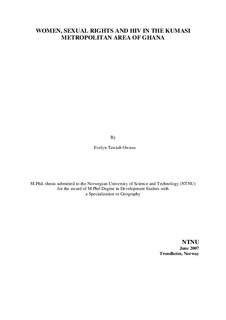Women, sexual rights and HIV in the Kumasi metropolitan area of Ghana
Master thesis
Permanent lenke
http://hdl.handle.net/11250/265201Utgivelsesdato
2007Metadata
Vis full innførselSamlinger
- Institutt for geografi [1096]
Sammendrag
This study is about women, HIV/AIDS and sexual rights in the Kumasi Metropolitan Area in Ghana. The study aimed at discovering the factors that undermine women’s ability to negotiate safe sex and consequently become exposed to HIV infection and the subsequent stigmatisation and discrimination.
The study applied ideas generated mainly from the theories of risk, stigmatisation and discrimination and feminist geography to explain its findings. However, some ideas were also utilised from the empowerment approach. Of particular importance is that concepts like worry, risk perception, risk assessment, risk tolerance, risk optimisation, risk reduction, stigma, discrimination, gender inequality, gender identity and gender relations were applied in the interpretation of the findings.
The study focused mainly on women within the age group of 20 to 39. They included women whose HIV/AIDS status are not known, prostitutes, and HIV/AIDS positive women. In addition, the study included a few men within similar age group, key informants and stakeholders. A total number of 111 informants participated in the study. 80 women were selected for the questionnaire survey using semi-random sampling by age and sex and the remaining informants were purposely sampled. Both quantitative and qualitative methods were used for data collection and data analysis. Methods used for collecting primary data include questionnaire, in-depth interview, and direct observation. Secondary data were also collected from documentary sources. Univariate, bivariate, and multivariate methods were used.
The study revealed that gender inequality in HIV/AIDS persists in the study area. It further reveals that most women are worried for contracting HIV. Also it found out that women have higher perception about HIV and this has influence on their behaviour. However, there is exceptional case where some women with high perception about HIV still engage in risky behaviour. The study also reveals that HIV risk tolerance is generally high at both the local and national level. Caution was revealed as the most preferred measure for risk reduction. Low income or low economic status was revealed as the most important factor undermining women’s inability to negotiate for safe sex. Most women also favour that women are given some form of control over their sex. Furthermore, the study reveals that gender inequality which is evident through biological, economic, socio-cultural and political subordination of women make them vulnerable to HIV, stigmatisation and discrimination.
The study recommends measure such as expanding women’s access to sexual and reproductive health, expanding public education programmes, promoting and protecting women’s right, empowering women, giving women access to antiretroviral treatment and political commitment for reducing women’s vulnerability to HIV, stigmatisation and discrimination.
